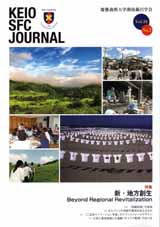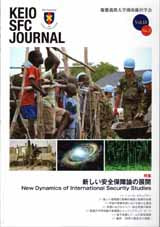- HOME
- KEIO SFC JOURNAL
- Vol.16 No.1

KEIO SFC JOURNAL Vol.16 No.1 Reconstruction from the 2011 Tohoku Earthquake and Tsunami, and New National Spacial Strategies under the Condition of Population Decline
published on 2016.09
SPECIAL FEATURE: Reconstruction from the 2011 Tohoku Earthquake and Tsunami, and New National Spacial Strategies under the Condition of Population Decline
-
Foreword
Download this article (PDF): SFCJ16-1-00.pdfTomohiro Ichinose Professor, Faculty of Environment and Information Studies, Keio University)
-
2011 Tsunami Disaster and Ecosystem-based Disaster Risk Reduction
Tomohiro Ichinose Professor, Faculty of Environment and Information Studies, Keio University A magnitude 9.0 earthquake struck the costal regions along Pacific Ocean in northeastern Japan on 11 March 2011. The subsequent tsunami wrought destruction on a massive scale. Kesennuma City was one of the heavily damaged regions in Miyagi Prefecture. I analyzed the habitat loss in the tsunami affected area of the city by using historical topographical maps in 1913 and 1955, and vegetation maps in 1981 and 2011. The area of urban land use has dramatically increased more than nine times for 100 years while the area of rice paddy field has sharply decreased from 52.9% to 17.9%. It was estimated that totally 113.5 billion yen and 66 million yen of the benefit from natural ecosystems lost by the tsunami due to urban and agricultural land uses, respectively.
Download this article (PDF): SFCJ16-1-01.pdf -
Practice of Co-creative Reconstruction in Northeastern Japan for Building Resilience
Wanglin Yan Professor, Faculty of Environment and Information Studies, Keio University Rob Roggema Director, Cittaideale / Adjunct Professor, Center for Design Innovation, Swinburne University of Technology Akihiro Oba Senior Researcher, Keio Research Institute at SFC Luke Middleton Director, EME Design Pty Ltd Takahiro Kanamori Master Program, Graduate School of Media and Governance, Keio University It is often criticized that the post-3.11 reconstruction is behind the schedule. However, we should not forget the complexity of the triple disasters. It is difficult to capture a big picture of the reconstruction because of the wide region and uncertainty of the situation. This paper reviews the features of the disasters and the barriers in reconstruction through the lens of resilience. Based on the practice of charrette design workshops in Minamisoma City and Kesennuma City, we propose a co-creative approach for reconstruction with four components: intermediate organisation, citizen community, spatial planning, and implementing projects. The four components work together to form a creative vision of reconstruction rooted in the intrinsic resources of the areas. A charrette design workshop provides a platform for this co-creation, and spatial planning spatially harmonizes a variety of intrinsic resources and reconstruction projects toward the resilient reconstruction vision. Further cases are needed to validate the applicability of this approach in other cities.
Download this article (PDF): SFCJ16-1-02.pdf -
Some Epidemiological Findings from Fukushima Daiichi Nuclear Power Plant Disaster
Tomoyuki Furutani Professor, Faculty of Policy Management, Keio University This study aims to introduce several parts of author's experiences regarding monitoring, visualizing and epidemiological analysis on environmental radiation after Fukushima Daiichi Nuclear Power Plant Disaster. First of all, the author introduces possibilities and limitations of data science for risk communication especially on nuclear disaster. Secondary, analysis results on internal radiation exposure surveys in Hamadori area (ex. Minamisoma city) are shown. Thirdly, differences of healthcare impact of evacuators and returners after the disaster are statistically compared.
Download this article (PDF): SFCJ16-1-03.pdf -
The Great East Japan Earthquake as seen from Austria
Johannes Wilhelm Lecturer, Department of East Asian Studies, University of Vienna 70 This paper represents a desciptive and comparative analysis of the Great East Japan Earthquake (3.11) as seen from Austria. The paper first deals with the evolution of the metonymy "Fukushima" in Austria by looking at events in Austria's contemporary history to reveal some reasons for the Austrian views on 3.11. In a second part, the author reflects on what can be learned from Austria in the context of post-disaster Sanriku focused on how life-satisfaction can be achieved within reconstruction efforts from a personal point of view.
Download this article (PDF): SFCJ16-1-04.pdf -
Revitalization of Community and Individual Initiative in the Process of Pre- and Post-Disaster
Satoko Oki Associate Professor, Faculty of Environment and Information Studies, Keio University This article explains what is essential to prevent or mitigate natural disaster. I first describe the limitations of earthquake science exposed by the 2011 Tohoku Earthquake, and report the tragedy caused by the seismologists' unconsciousness of these limitations. Then introduce the significance of involving citizens, instead of professionals and local government off icers, to the mainstream of disaster prevention. This article also refers to the revitalization from the disaster, focusing especially to the process of constructing the giant sea walls. Revitalization without community and individual's initiative will pervasive the sense of inability and dependence to the public help, and result in the vulnerability of the citizens.
Download this article (PDF): SFCJ16-1-05.pdf -
The Role of Information Technology for Relief Assistance of Large-scale Disaster
Shoko Miyagawa Associate Professor, Faculty of Nursing and Medical Care, Keio University Information technology (IT) is indispensible for obtaining, analyzing and utilizing the information needed to make support decisions in the aftermath of largescale disasters, but the reality is IT usage is hardly optimal for disaster management. Survey results of civilian disaster relief organizations show that while over 80% implemented IT solutions, the lack of IT personnel and skill as well as a framework for collecting, analyzing and sharing information is a big issue. We introduce two cases of organized IT support by IT professionals in order to resolve these issues and discuss its possibilities and required structure.
Download this article (PDF): SFCJ16-1-06.pdf
-
Walking Accessibility Assessment of Elderly People in Collective Relocation after the Great East Japan Earthquake -A Case Study in Kesennuma City, Japan
Takahiro Kanamori Master Program, Graduate School of Media and Governance, Keio University Wanglin Yan Professor, Faculty of Environment and Information Studies, Keio University Five years have passed since the 2011 Great East Japan Earthquake and at present collective relocation is being carried out all over the tsunami stricken area. While safety is much improved it is considered that the lifestyle of the migrated residents is to be affected. In this research, the effect on the lifestyle of migrants was analyzed in Kesennuma City by looking at walking accessibility of elderly people's physical burden. The accessibility to be nearest public transport from each collective relocation site including topographic aspect was assessed. The result shows that 90% of collective relocation sites are located out of walkable distance from the closest bus stop.
Download this article (PDF): SFCJ16-1.07.pdf
-
Intelligent Drift Reduction in Inertial Sensor Orientation Estimates Using Elementary Motion Knowledge
Heike Katrein Brock Doctoral Program, Graduate School of Media and Governance, Keio University Yuji Ohgi Professor, Graduate School of Media and Governance, Keio University In this paper, we discuss a strategy for motion dependent drift reduction in orientation estimates from inertial measurement units. Measurements showed that drift evoked from sensor noise could be very present in the orientation estimates when the raw sensor data was processed uniformly over diverse motion patterns. Independent of the employed processing filter, angular accuracy especially varied with the amount of angular velocities and the number of motion dimensions involved. We therefore categorized those dominant motion properties and used the resulting annotations to add a flexible drift compensation to the underlying estimators. Results showed that data accuracy increased by taking such elementary motion characteristics into account. Using a-priori motion knowledge, the presented intelligent drift compensation can contribute to higher data quality in automated kinematic analyzes of sport motions in future.
Download this article (PDF): SFCJ16-1.08.pdf -
SKL Tagging -A Method for Generating Dominant-negative Inhibitors of the Homeobox Transcription Factor Superfamily and Smads
Yuka Sato Master Program, Graduate School of Media and Governance, Keio University Shinya Matsukawa Postdoctoral Fellow, Axial Pattern Dynamics, RIKEN Center for Developmental Biology Hiroki Kuroda Associate Professor, Faculty of Environment and Information Studies, Keio University Peroxisome targeting signal 1 (PTS1) is a C-terminal tripeptide with a consensus sequence such as serine-lysine-leucine (SKL). Using this molecular mechanism, we developed a novel dominant-negative assay, designated the SKLtag trap assay, to negatively regulate dimeric transcription factor, as typified by the homeobox transcription factor superfamily. We tested this method on the homeobox protein Siamois, a well-studied dorsalizing factor in vertebrates, with Vent1 and Vent2 as ventralizing factors. In both cases, protein functions were effectively blocked by the SKL-tag trap assay. Moreover, we showed that the technical feasibility of the SKL-tag trap assay was confirmed for Smad transcription factors. Taken together, we conclude that the SKL-tag trap assay can be used for the effective way to inhibit function of dimeric, trimeric, and oligomeric transcriptional factors in amphibian embryos.
Download this article (PDF): SFCJ16-1.09.pdf -
The Use of Listening Comprehension Strategies and Note-taking to Recall on TOEFL -The Effects of Learners' L1 Backgrounds and Proficiency Levels
Yunlong Liu Doctoral Program, Graduate School of Media and Governance, Keio University The present study aimed to discover how listening comprehension strategies and note taking could be used to recall the content of passages on TOEFL. The independent variables were learners' L1 backgrounds (Chinese and Japanese) and English proficiency levels (intermediate and advanced). The results showed that the advanced listeners were more adept at recalling the gist and complete meaning groups of a lecture, and took advantage of linkage words, notes, and the relationship between sentences to recall information. The study also revealed differing patterns between Japanese and Chinese learners in terms of how they recalled the content of the lecture, and of the quality and the quantity of the notes they took. Specifically, the test-answerability score of the Chinese participants in the study was higher than that of the Japanese participants. The Chinese participants used more content words in their mother tongue to take notes than their Japanese counterparts, but the Japanese participants included more words in their notes. The results of the study provide both theoretical contributions to SLA and pedagogical implications for the foreign language.
Download this article (PDF): SFCJ16-1.10.pdf
-
Recent Developments in Human-Insect Studies -With Special Reference to L. J. Moore and M. Kosut's BUZZ
Satoshi Watanabe Lecturer, Faculty of Contemporary Management, Aichi Gakusen University
*The affiliation at the time of posting is Senior Researcher, Keio Research Institute at SFC, Keio University.Human-insect studies is a newly emerging research field in Western countries. Its fundamental perspective is that both humans and insects are actors that create and participate in the world together, and are created by the world. Focusing on insects' ambivalent status for humans, Human-insect studies has elucidated that the relationship between humans and insects has been transformed in the contemporary world. The author points out that this achievement implies that Human-insect studies has the potential for radically exploring the future modes of existence for humans and insects, and improving the relationship between them. L. J .Moore and M. Kosut's BUZZ provides a good starting point for exploring these issues.
Download this article (PDF): SFCJ16-1.11.pdf

